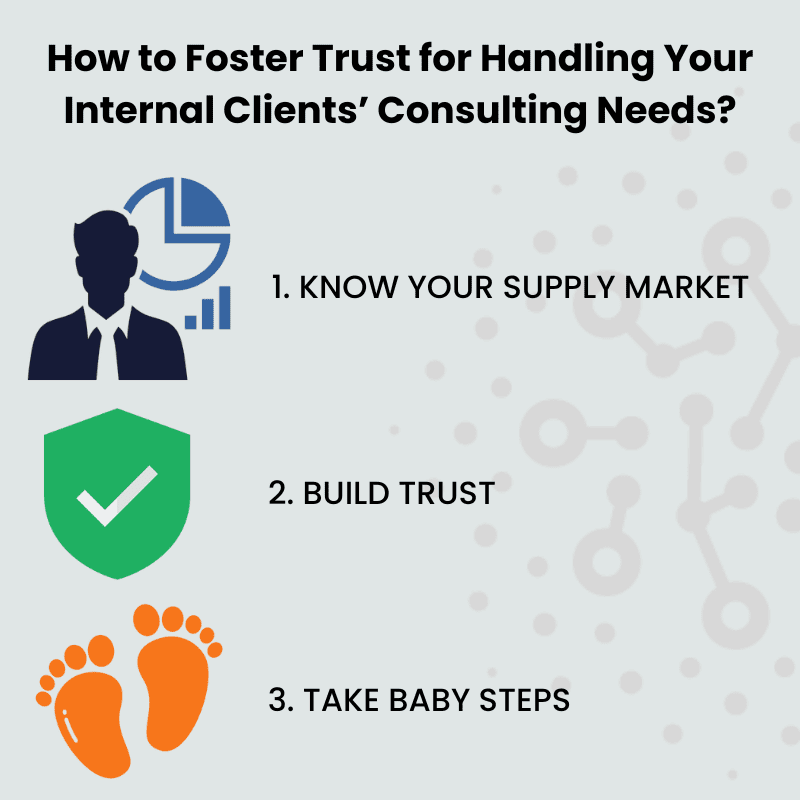Most procurement executives go out of their way to support their business lines. They scratch their heads to reconcile their internal clients’ needs and the increased pressure on savings and productivity.
The function is going through fundamental changes: shifting from tactical to strategic, from savings to value creation, often amid a digital transformation. The current pandemic is just the last straw.
“Trust is like the air we breathe–when it’s present, nobody really notices; when it’s absent, everybody notices.”- Warren Buffet
Yet, in many companies, the business lines continue to avoid working with them when sourcing consultants. Or when they involve them in the process, it is often at the negotiation phase, when the impact procurement can bring is minimal.
Why are procurement executives sidelined when dealing with consulting services? It is an easy answer: TRUST.
Consulting is a human-to-human service. The trust factor is core to both the selling and the buying side. The only way to be involved at the early stage of the process is to build trust with both your internal clients and your consulting providers.
So how do you do that?
1. Know Your Supply Market Inside Out
How many consulting firms serving your industry can you name? We all acknowledge that having a good grasp of the supply market is critical to get the best sourcing outcomes.
The consulting market is extremely diverse and complex. Consulting firms are not commodities that can be swapped without impacting the quality or the price of a project.
Understand How Consulting Is Structured
When you look at a consulting provider, you need to understand what they do (capabilities), who they work with (clients), and what experience they have (industries served).
Many dimensions can impact how consultants do their work and what value they can bring.
- Size and Geographic footprint
- Ownership structure
- Profile of Partners
- Delivery Model
Each of the dimensions will influence the type of projects a consulting firm can take and how they will deliver the results.
To go further: Global Consulting Industry: a comprehensive guide
Research Consulting Firms within Your Industry
You should start with internal sources such as your existing list of preferred providers and your network/colleagues that have worked previously with Consultants.
Of course, you will also find many sources online, such as Improveo.app, a reference platform of consulting firms that organizes them per region, capability, and industry served.
Another interesting research source is thought leadership, in particular, articles and books written on the field you are interested in. Don’t hesitate to use several sources to find new players.
Understanding your options can cause you to explore innovative solutions and get the most of your consulting.
Go further: How to Buy Consulting Services like a pro: The Definitive Guide
Get a Grasp of the Economics
Consultants are selling their time, or more precisely, the access to expert knowledge and execution workforce during a certain period of time. The potential of production of a Consulting is the amount of time available for billing.
Every day not billed is lost just like an empty airplane seat. So the fee structure is usually geared to optimize the utilization rates.
Understanding the different fee structures and the elements that impact a project price will help you during the scoping and the negotiations phase.

2. Build Trust with Your Internal Clients
Collaboration and trust are the cornerstones of consulting success. In order to squeeze yourself into the relationship between clients and consultants, you need to develop relationships with both sides.
Listen to Your Business Lines to Understand Their Needs
Working efficiently with business lines when sourcing consultants requires anticipation and reactivity. Indeed when they need a consulting provider, they usually want it for yesterday.
Unless you have a list of potential candidates at hand, they will just move forward without waiting for you.
Some companies have strong-armed their business lines and force them to slow down to match their procurement teams’ pace.
The results are often disastrous in terms of quality and timing, and the business lines, frustrated, find ways to work around the stringent policies.
Most of the needs of your internal clients are recurrent or predictable. You can start identifying and qualifying potential providers way before your colleagues will need them.
Get to Know Your Providers
As surprising as it may sound, identifying a Consulting Firm with the right expertise only gets you half-way there. Each consultancy has a portfolio of projects where they excel.
As a procurement executive, you need to know their sweet spot to ensure you have all your needs covered with only the best.
The intimacy between a Consulting Firm and its clients can facilitate and accelerate projects. Developing relationships with consulting providers will help them better understand your business, culture, and values.
They will become “plug-and-play” for your internal clients.
Go further: Supplier Relationship Management for consulting : The Definition Guide
3. Start Taking Baby Steps
Embarking on a transformative journey requires patience and perseverance. It’s essential to remember that even the most persuasive ideas won’t instantly alter the entrenched practices your company has been using to purchase consulting services.
Find Your Champion
Somewhere within your organization lies a key player, a forward-thinking leader who’s ready to embrace innovative approaches. This individual can be the linchpin in your efforts. They’re not just any ally – they are your champion.
Aligning yourself with them means introducing new players into a consulting bid becomes a shared mission. This collaborative approach isn’t just about change – it’s about speeding up the rate of adoption.
Be Prepared. Deliver Value
The onus is on you to discover new consulting firms that offer unmatched expertise tailored to the project in question. Dive deep, research extensively, and gather substantial evidence of their capabilities.
Asking for and diligently verifying references is crucial. Coming prepared isn’t just about ticking off boxes – it’s about cementing your position as someone who brings genuine value to the table.
Crafting Your Case for Change
Once your sourcing phase concludes, it’s time for introspection. Analyze the outcomes. Assess the tangible savings made by the company. Understand the perceptions of your internal stakeholders regarding the entire process.
Did they find it seamless? Were there hiccups? More importantly, if they were standing in your shoes, how would they tweak the process? Your case for change isn’t just about showcasing the organizational benefits.
It’s also about highlighting the personal gains each stakeholder stands to achieve. Remember, everyone’s more inclined to support a change when they see what’s in it for them.
Concluding Thoughts: Grow as You Go
As you steadily amass data and experiences, you are also building a treasure trove of evidence that can validate your approach. With substantial insights in hand, approach your manager with confidence.
Present your proposal, not just as an idea, but as a tested strategy with tangible results. Advocate for scaling up, by encompassing more business lines within a designated perimeter.
Your results and deepened understanding of consulting will soon become your calling card. They’ll vouch for your capabilities, turning heads and winning nods. Yet, it’s crucial to remember the art of discernment.
While it’s tempting to embrace every project that comes your way, doing so can become counterproductive. Instead, think of your knowledge as a valuable resource. Package this expertise and share it.
Train your colleagues, enabling them to source their projects effectively. By doing so, you free yourself to delve into uncharted territories, discovering new players and managing large-scale, strategic projects.
Imagine your journey as a series of concentric circles. Begin at the core, with a compact set of tasks. As you gain expertise and confidence, expand outward, incorporating more and more projects into your domain.
This iterative approach doesn’t just ensure growth; it embodies the very essence of ‘learning on the job’. As you chart this course, remember: the beauty lies in growing as you go.
internal clients internal clients internal clients internal clients
internal clients internal clients internal clients internal clients
internal clients internal clients internal clients internal clients

How Consource Can Help?
Consource can assist you to expedite consultant sourcing by 50% using our smart user interface, self-service portal, and templates libraries. With Consource you can source the best value-for-money consultants through competition by combining your panel and our network.








0 Comments